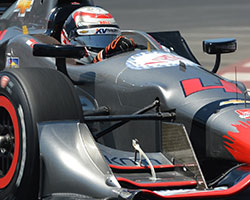Circuit breaker? Drivers close in on track record
APR 17, 2015
Click it: Combined practice results || Practice 2 results || Practice 1 results
LONG BEACH, Calif. -- Will Power and Team Penske teammate Simon Pagenaud recorded lap times in the second Verizon IndyCar Series practice session for the 41st Toyota Grand Prix of Long Beach that were quicker than the 2014 Verizon P1 Award-winning time of Ryan Hunter-Reay.
An assault on Sebastien Bourdais' nine-year-old track record is assured in qualifications (6 p.m. ET, NBCSN) April 18.
A 45-minute practice session at 1 p.m. (ET) precedes the three rounds of qualifying to determine the Verizon P1 Award winner and set the grid for the 80-lap race April 19 (4 p.m. ET on NBCSN).
Power, driving the No. 1 Verizon Team Penske Chevrolet, led the 23-driver field with a lap of 1 minute, 07.5485 seconds. Pagenaud was .0370 of a second back in the No. 22 Penske Truck Rental Chevrolet. Eighteen drivers were within a second of Power's quick lap on the 11-turn street circuit.
“A lot of cars were running and laying rubber, but with the new aero kits and everything, the cars were just faster," said Power, who was runner-up in the 2014 race and won in 2012 and 2008. "It’s always super tight around here when it gets to qualifying. The top six are usually separated by about a tenth and a half (of a second) or something."
Bourdais set the track lap record at the 1.968-mile configuration, which has been in place since 2000, at 1:06.882 in 2006. He went on to win -- the middle victory of three in a row at Long Beach. Hunter-Reay earned the Verizon P1 Award last year with a lap of 1:07.8219 in the No. 28 DHL car for Andretti Autosport.
The two other Team Penske drivers, Helio Castroneves (1:07.9132) and Juan Pablo Montoya (1:08.0539), also were in the top five. Scott Dixon, who was quickest in the first session (1:08.6458) in the No. 9 Target Chip Ganassi Racing Chevrolet, was fourth (1:07.9671) in the late-afternoon practice.
 Bourdais, driving the No. 11 Team Hydroxycut-KVSH Racing car, joined the 11 other drivers of the Chevrolet engine/aero kit to run on the circuit without the vertical front-wing assembly "winglets." As part of the ongoing development of the aero packages, INDYCAR requested the following actions of both manufacturers to be implemented by race time:
Bourdais, driving the No. 11 Team Hydroxycut-KVSH Racing car, joined the 11 other drivers of the Chevrolet engine/aero kit to run on the circuit without the vertical front-wing assembly "winglets." As part of the ongoing development of the aero packages, INDYCAR requested the following actions of both manufacturers to be implemented by race time:
* Chevrolet to add a tether to the winglets or remove them from the front wing assembly.
* Honda to implement additional reinforcements to its rear-wheel guards.
The first step in this process began with last week’s mandate of structural upgrades to both manufacturers' components and will continue as the season progresses and opportunities for improvements are identified.
"We applied an additional layer of carbon in a couple of spots to further strengthen the parts, and those made their debut at NOLA," Honda Performance Development COO and vice president Steve Eriksen said. "I'm pleased with how it turned out. We had a number of instances of car-to-car contact during that race and we did not have a single instance of parts coming off the car. If all goes well at Long Beach, our plan is to essentially take that strength as a benchmark and make the original shape with that new strength level for replacement parts."
Eriksen said he has suggested to INDYCAR to allow HPD to tie the rear-wheel guards to the main plane.
"Why not connect those together? You're going to form a box that's much more solid," he said. "We'll see if they agree to that. If so, then we'll look at doing that in the future."
For the race weekend at NOLA Motorsports Park, Chevrolet added a flange at the base of the vertical winglet.
With or without the winglets on the Chevys, Bourdais said drivers are quickly getting a handle on the new aerodynamic bodywork package. It's now about optimizing the platforms for each road/street course, and track records will follow.
"Anywhere we go we'll have between 400 and 800 pounds more downforce, which is noticeable but not the revolution that we saw in St. Pete," said Bourdais, driving the No. 11 Team Hydroxycut-KVSH Racing Chevrolet. "If you were at max downforce last year and are at max downforce now with the aero kit, you'll see a bigger reduction in lap time.
"From a 60-degree day to a 90-degree day you'll see more variations than between the two aero kits. It was one of the concerns when the kits were introduced. How long is it going to take us to figure these things out? It was a relief when we ran the cars. Yeah, it's a little different but you got accustomed to it rather quickly. It's always nice to run more downforce. The car is more settled, it's more responsive and it goes quicker."






















